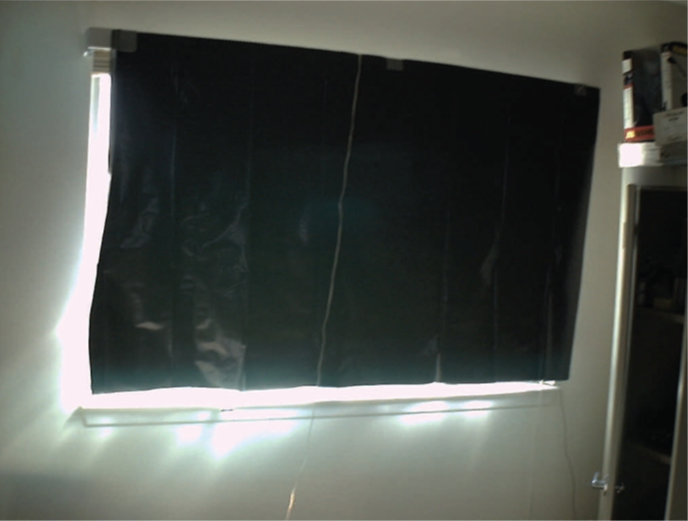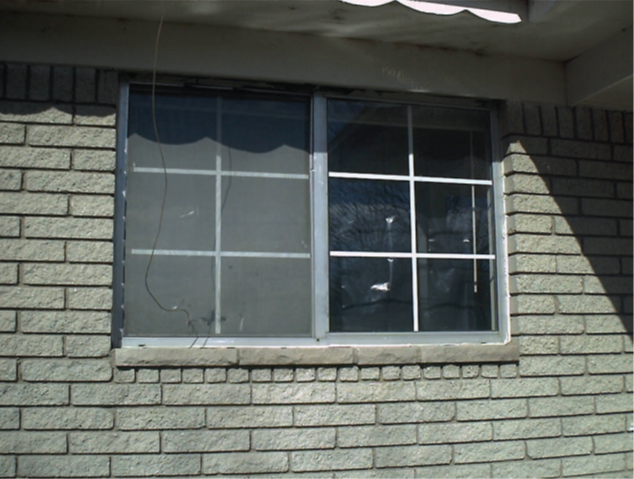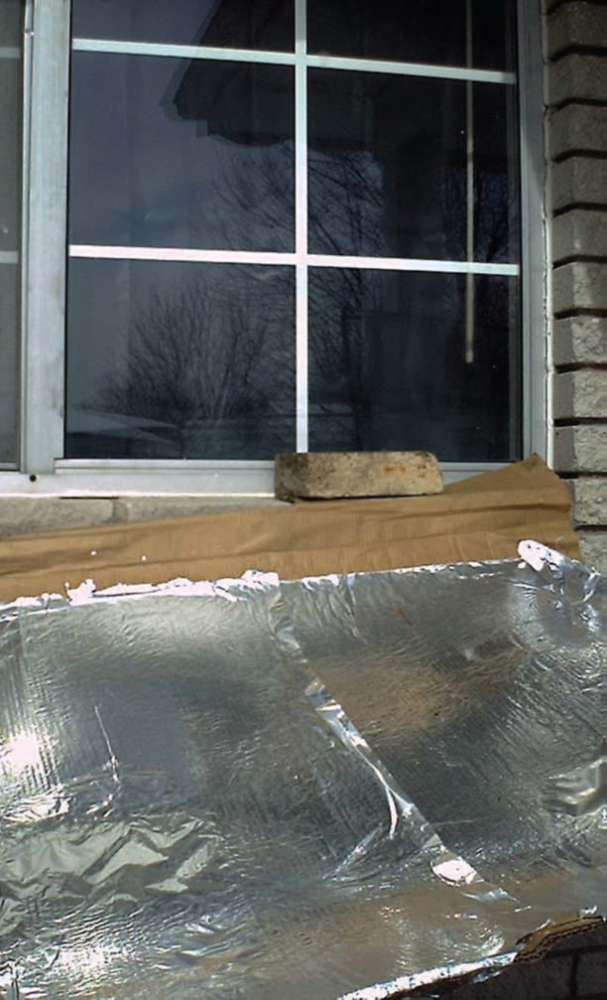No Joke, this chapter could save your life.
If you get into a situation where a natural disaster has shut off your power, you can use this method to keep your house warm.
Usually, once a storm passes, the sun comes out and it is a beautiful day. Here is what you're going to do.
Once again, this is very simple. So simple it is easy to underestimate the amount of solar power and heat you can get from such devices. Use care and caution. You are literally “playing with fire.”
Here is a simple convection solar window heater, published in “Sunshine for Dollars”, by Steven Harris, you can make for .25 cents.
For optimum heat, you need:
- South or west facing windows, but any window where to sun is shining through will do.
- 3 mil. Black plastic
- A curtain rod over the window.

Black plastic taped to curtain rod
What you’re going to do:
Simply hang the black plastic over the curtain rod so that it covers the full length of the window.
That really is about all there is to it.
Here’s what’s going to happen:
The suns heat will enter the window, heating up the back plastic. The colder air of the room, will enter through the bottom of the plastic.
The hotter air, will exit back into the room through the top.
Simple. Easy. Economical. And it works. It works better than you think,
OK, I know what you’re thinking…I just can’t go and black plastic all of my windows. You’re right, you can’t. This exercise is a small sample to get you to understand what CAN BE DONE, simply, easily, cost-effectively.
Every situation is going to be different.
However, think about this for a moment…

If you live in a colder part of the country, or climate, and you’re having to pay $500-$1,000 dollars a month for heating, and you could heat a few rooms of your house during the day, using this simple, painless, technique…how much money would you save? (let’s also keep in mind that by now you should air sealed your home and can now keep that heat in longer.)
More than the cost of this course, anyway.
Now then, let’s take a look at a simple way to AMPLIFY the heat using this unit.

WHY IS THIS DIFFERENT?
What is different about this and sunshine just falling into a room? In Thermal Science, it is called QUALITY. Simply put, heat quality is the temperature of the energy.
When sunshine normally falls into a room, it will hit the carpet, a desk, a paper, a wall, or a sleeping dog. All of these items reflect, absorb, and bounce the light in a different fashion. Some light gets bounced onto the ceiling where part of the energy gets absorbed and reradiated as heat, while some of it gets reflected to other parts of the room.
WHY IS THIS DIFFERENT?
What is different about this and sunshine just falling into a room? In Thermal Science, it is called QUALITY. Simply put, heat quality is the temperature of the energy.
When sunshine normally falls into a room, it will hit the carpet, a desk, a paper, a wall, or a sleeping dog. All of these items reflect, absorb, and bounce the light in a different fashion. Some light gets bounced onto the ceiling where part of the energy gets absorbed and reradiated as heat, while some of it gets reflected to other parts of the room.
The black plastic sheet is VERY receptive in the absorption of sunlight, and absorbs most of the sunlight in one limited spot of air between the plastic and the glass. This reduces how fast the heat can get away and allows the air to get hotter (have a higher quality). The black plastic absorbs the ultraviolet (visible and infrared wavelengths of sunlight) that make it through the glass, and re-radiates the energy as long wavelength infrared light. You can mildly feel this on your face when standing close to the plastic.
Cool air thermally siphons from the bottom of the plastic, warms up, and moves out the top of the plastic/window air gap. This simple trick noticeably warms the room up, making it feel much more pleasant. The whole window can be blocked with plastic, or only part of it can be blocked to save some of the view. I used a three Mil, black piece of plastic I got from Home Depot, but a black trash bag will work almost as well.
Now then, let’s step it up a notch…

I added a reflector outside the window to bounce more sunshine into the window. This actually puts “TWO Suns” onto the window, the sun that normally falls through the window and the reflected sunlight. This is called TWO SUNS. If I had a second reflector, this would be a total of “Three Suns” (DO NOT DO THIS).
Before the sunshine hid behind the clouds last four days here in Michigan, this reflector quickly got my air out temperatures above 85°F, and the sunshine was a little hazy.
With my solar oven experience, I think this would of easily gotten over 100°F with a February sunshine in Michigan.
The reflector is aluminum foil with Elmer's glue on cardboard. I am going to re-do this with flat masonite. Adding a hinge or two allows for easier adjustments (rather than using the displayed brick method.)
DO NOT add more than ONE reflector to your unit. When it gets warmer and the sun gets stronger, multiple reflectors *WILL* actually get the plastic so hot that it WILL literally go POOF and up in flames. ONE reflector with REGULAR aluminum foil is more than enough. It is true that in areas like Michigan, we have a limited number of sunny days in December.
However, we have more sunny days in January, February and March, but it can EASILY be well below freezing during these months. Even during April and May, it can be in the forties, fifty’s and sixties. I LIKE my house 70°F+, and on these days during half the year, this little solar air heater will add gentle warmth that my furnace or wood stove does not have to add. It does it all by itself. I don’t have to turn it on. The project can be done in ten minutes, and I can take it down and put it up in seconds. This project can also be done by anyone in an apartment.
This Week’s Assignment
1) Choose a sunny, out of the way room in your house. Try putting up a black plastic curtain. Turn off the heat to that room. Using your hand as a thermostat, try it for yourself! Feel the cooler air enter the bottom, and warmer air exit the top. In some rooms of the house, (Like bathrooms) you could use this simple method to heat the room during the day.
2) Begin brainstorming ideas: Once you understand this simple heat concept, expand it to other areas of the house. Try using a reflector. Even a partial window covering and a reflector will generate enough heat on a sunny day to heat most rooms. Add to as many rooms as feasible. Always keep safety in mind.
3.) This lesson serves as a backdrop to more complex (and money saving) lessons to come. Understanding the simple concepts involved here will help you make decisions later on.
PS…Don’t forget you can get personalized coaching. For some this is the ideal way to get hands on experience as well as personal attention needed to make this work for you.
